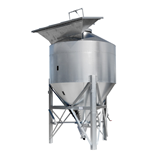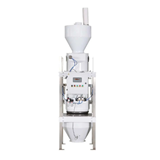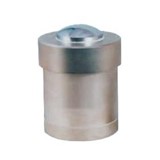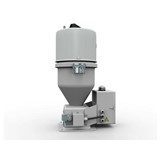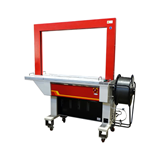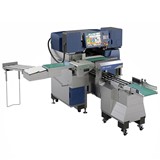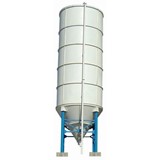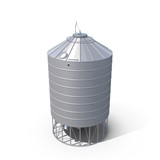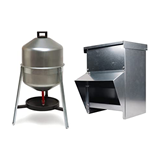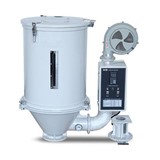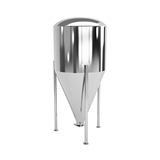Compare hopper & silo prices in Australia. Discover types, costs, financing & compliance tips to buy the right bulk storage system for your business.
Key takeaways
- Hopper & silo prices in Australia typically range from $4,000 to $150,000+, depending on capacity, materials and custom features like aeration or weight batching.
- Popular capacities include:
- 5–30 tonne hoppers: $5,000–$15,000
- 30–100 tonne silos: $20,000–$70,000
- Custom-designed units with automated discharge or weighing systems: $80,000+
- Maintenance costs can range from $500–$2,000 annually, mostly for cleaning, safety checks and discharge system servicing.
- Financing options like equipment loans or asset leases can help spread cost over 3–5 years, with rates from 6.5%–9.5% p.a.
- Compliant silos and hoppers in Australia must meet AS 3774-1996 and AS/NZS 1170, along with state-based safety and structural integrity codes.
Introduction
Whether you're in agriculture, food processing, mining or manufacturing, hoppers and silos are critical infrastructure for storing and discharging bulk materials efficiently. Choosing the right solution can improve workflow, reduce material waste and lower operational costs. But buying one in Australia involves more than just picking the cheapest unit—you need to consider the right type, pricing, compliance, operational needs and total cost of ownership.
This guide breaks it all down for you—from prices and types to maintenance, warranties and certification requirements—to help you buy with confidence.
Types of hoppers and silos
1. Hoppers
Hoppers are typically short-term material holders that allow gravity-based discharge through chutes or feeders. Common types include:
- Conical hoppers: Ideal for free-flowing materials like grains and pellets.
- Rectangular hoppers: Used where space is limited or for integration into systems.
- Weigh hoppers: Integrated with scales for batching and dosing.
2. Silos
Silos are tall, large-capacity vessels used for long-term storage. They come in several forms:
- Flat bottom silos: Suitable for high-volume, long-term storage (e.g., grain).
- Cone bottom silos: Designed for complete discharge, often used in plastics or food.
- Bag silos: A cost-effective temporary solution, often seen in farming operations.
3. Specialised options
- Mobile silos: Transportable storage for on-site batching and construction use.
- Pressurised hoppers: For conveying materials under air pressure.
- Modular silos: Expandable units, ideal for growing operations.
Hopper and silo prices in Australia
Pricing for hoppers and silos in Australia varies significantly based on capacity, construction materials, and additional features such as aeration, automation, or level monitoring. Below is a general guide to help you understand what to expect in 2025:
- Small hoppers (typically 1–2 tonne capacity) made from stainless steel or galvanised steel generally start from $1,000 and can go up to $6,000, depending on the finish and any discharge accessories included.
- Medium-sized silos with a capacity between 10 to 30 tonnes are often used on farms or in smaller processing operations. These typically range from $10,000 to $30,000, with variations depending on the inclusion of safety ladders, aeration systems, and grain monitoring devices.
- Large silos, designed to store 50 to over 100 tonnes, are more common in commercial grain storage, feedlots, or industrial facilities. These generally cost between $30,000 and $90,000+, depending on the height, wall thickness, construction material, and optional features such as automated discharge systems.
- Custom-designed silos with integrated automation, load cells, or food-grade interiors can exceed $100,000, especially if designed for complex manufacturing or bulk processing applications.
Key Considerations Before Purchase
1. Capacity and Size Requirements
- Determine storage volume: Understand your operational needs by calculating the volume of material to be stored.
- Flow rate: For unloading, the flow rate of the hopper should align with your processing or distribution needs. Too slow a discharge rate can lead to inefficiencies.
- Future growth: Consider future capacity expansion to avoid outgrowing your hopper or silo too soon.
2. Material Compatibility
- Stored product: Ensure the hopper or silo is designed for the specific material you plan to store (e.g., grain, cement, chemicals).
- Corrosion resistance: Consider whether the material requires specialized coatings to prevent corrosion, especially in industries such as food processing, agriculture, or chemicals.
3. Installation and Site Preparation
- Space and access: Ensure adequate space is available for installation, ongoing maintenance, and potential expansion.
- Foundation requirements: Silos, especially tall or large ones, may need reinforced foundations or specific structural preparations.
Operation and installation considerations
Installation requirements
- Foundations: Must be level and designed for the weight load of the filled unit.
- Access: Ensure space for truck loading/unloading and maintenance.
- Height clearance: Especially important for fixed silo structures.
Operational features to look for
- Aeration systems: Prevent moisture buildup in grain silos.
- Discharge valves: Ensure smooth material flow.
- Level indicators: Help avoid overfilling.
- Integrated weighing systems: Common in food and chemical industries.
Maintenance and servicing
Regular maintenance improves lifespan and safety. Key tasks include:
- Visual inspections for corrosion, structural fatigue, and weld integrity.
- Cleaning of interior surfaces (especially for food use).
- Lubrication of discharge gates and moving parts.
- Testing of safety mechanisms, pressure release valves and weighing systems.
Annual maintenance costs average between $500 and $2,000, depending on complexity and environment.
Key parts and components
Here are the main components you should be familiar with when buying or replacing:
- Shell and legs: Determine load-bearing capacity.
- Discharge system: Slide gates, screw feeders or rotary valves.
- Sensors: For level detection and weight measurement.
- Access ladders and safety cages: Required under WHS compliance.
Warranties and after-sales support
- Standard warranties: 1–2 years for structural components.
- Extended warranties: Up to 5 years on premium models.
- After-sales support: Check for local technician availability and access to spare parts.
Financing options in Australia
Investing in hoppers and silos can represent a significant upfront capital outlay—especially for large-scale or custom systems. Fortunately, a range of financing solutions are available to Australian buyers to ease the cash flow burden and preserve working capital. Here's a breakdown of the most commonly used financing options in 2025:
1. Equipment loan (secured business loan)
This is one of the most common ways to finance hopper and silo purchases. Under this arrangement, the asset (e.g. the hopper or silo) is used as security for the loan.
- Interest rates: Typically range between 6.5% and 9.5% p.a., depending on the borrower's credit profile, loan term, and equipment value.
- Loan terms: Generally between 1 to 5 years, though longer terms may be available for higher-value installations or with strong credit history.
- Deposits: Lenders may require a deposit of 10% to 20% to reduce their exposure.
- Ownership: You own the equipment from day one, and it appears on your balance sheet.
- Tax implications: You may be eligible to claim depreciation and interest payments as tax deductions, improving cash flow.
2. Finance lease
A finance lease allows you to use the hopper or silo for an agreed period while the lender retains ownership.
- Ownership: You don’t own the asset during the lease term, but may have the option to purchase it at the end (residual value payment).
- Flexibility: Ideal for businesses that prefer to preserve capital or upgrade regularly.
- Tax benefits: Lease payments are usually fully tax-deductible as an operating expense for eligible businesses.
- Terms: Typically range from 2 to 5 years, with a fixed residual or balloon payment at the end.
3. Chattel mortgage
This option is popular in industries like agriculture, food processing, and mining, where buyers want full ownership with tax efficiency.
- Structure: You take ownership of the hopper or silo immediately, and the lender registers a mortgage over the asset.
- Tax advantages: You can often claim the instant asset write-off (under current ATO rules) and GST on the purchase price upfront if you're registered for GST.
- Depreciation: The asset is listed on your books, allowing you to claim depreciation as a deduction.
- Interest rates and terms: Similar to equipment loans (6.5%–9.5% p.a. over 1–5 years), though terms can be tailored.
Compliance and certification in Australia
To operate legally and safely in Australia, hopper and silo installations must meet both national standards and state-based Work Health & Safety (WHS) regulations. Here's what to know before buying or commissioning your system:
Key Australian Standards
- AS 3774-1996 – Ensures structural safety of hoppers and silos under bulk loads.
- AS/NZS 1170 Series – Governs structural performance under wind, seismic and environmental loads.
- AS 4024.1 Series – Applies to automated systems, covering machinery safety and guarding.
- AS 2865:2009 – Required for confined space entry into silos for maintenance.
- HACCP standards – Essential for food-grade or feed-grade storage systems to ensure hygiene and compliance.
State-based WHS requirements
- Work at height – Ladders, platforms and fall protection must comply with Safe Work Australia codes.
- Confined space access – Trained personnel and documented procedures are required.
- Local authorities – Check with SafeWork NSW, WorkSafe VIC, etc., for state-specific rules.
Certification and inspections
- Engineering sign-off – A qualified structural engineer must certify designs, especially elevated or high-capacity systems.
- Third-party certification – Required for food-grade (HACCP) or export-bound products.
- Routine inspections – Visual and structural checks are recommended annually or biennially to meet compliance and insurer expectations.
Common questions from hopper & silo buyers
1. What size silo or hopper do I need?
It depends on:
- Daily or seasonal throughput
- Material density (e.g., wheat vs plastic pellets)
- Available site space
A good rule of thumb: Allow for 20–30% more capacity than daily usage to account for supply delays or emergencies.
2. Should I buy mild steel or stainless steel?
- Mild steel: Cheaper, suitable for non-corrosive materials.
- Stainless steel: Higher upfront cost, better for corrosive or food-grade materials.
3. Can I relocate a silo or hopper later?
- Mobile hoppers and modular silos can be relocated.
- Fixed concrete-base silos are not cost-effective to move once installed.
4. What permits do I need to install a silo in Australia?
- Development approval may be required, especially in urban or peri-urban zones.
- Some states require engineering certification and notification to WorkSafe.
5. How long do silos and hoppers last?
- Galvanised steel silos: 15–25 years with proper maintenance
- Stainless steel hoppers: Up to 30 years or more
Conclusion
Choosing the right hopper or silo in Australia involves balancing cost, capacity, material compatibility and compliance. Whether you're storing grain in Griffith or batching plastic pellets in Geelong, the right equipment can make all the difference in efficiency and safety. Always consult with your supplier about engineering specifications, installation support and after-sales service before purchasing.


